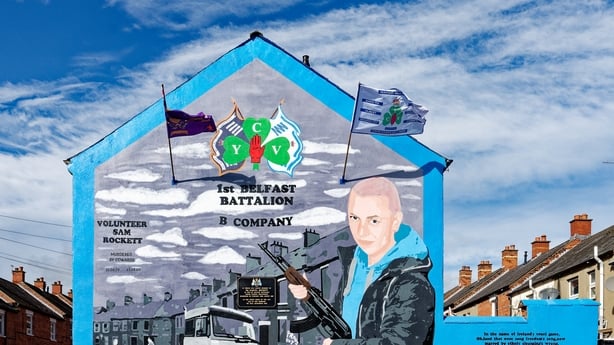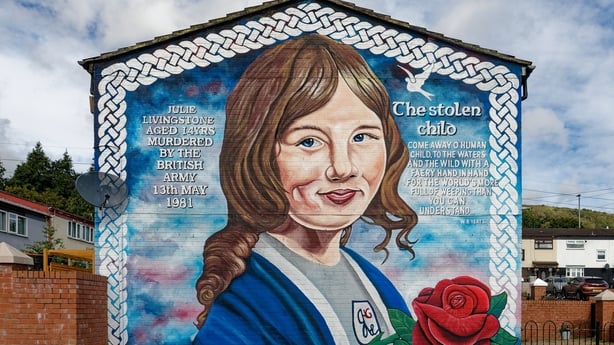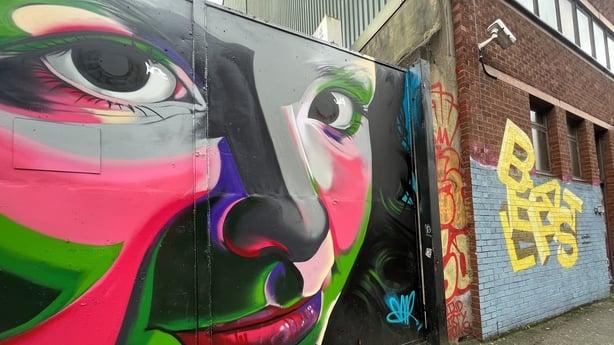Stuart Borthwick reckons he can tell more about the political temperature of Belfast from its walls than from its newspapers and broadcast media.
About 15 years ago the former academic from Liverpool developed an interest in the murals that adorn the city's gables.
He’s been back and forth ever since to photograph them and has published a book documenting them.
"They say something about history, but they also say something about now and I’m absolutely fascinated by them," he says.
When I ask him what they’re telling him today he says he gets a "vibe, a sense, a feeling" from them for how the communities in which they're are painted, are doing.
The images have changed over the years.
Sport, language, history and culture all now feature – a rich tapestry reflecting the diversity of Belfast.
In some cases these have replaced the more belligerent paramilitary ones.

But guns are still a feature on the walls of the city.
Thousands of tourists flock to the murals every year.
The International Wall on the Falls Road, where images of independence movements around the world feature, is a popular stop on the Belfast tour itinerary.
But there is one mural that Stuart Borthwick makes an effort to visit every time he comes.
It's in memory of Julie Livingstone, a 14-year-old girl killed by a plastic bullet fired by the British Army in west Belfast in 1981.

His birthday is the date the young teenager was shot - 13 May - and he was eleven at the time.
The fact that they were of roughly the same age gives him pause for thought.
"Whenever I come here to take a photograph of this mural I reflect upon that and in particular I reflect on the killing of children in the Troubles. And Julie Livingstone was not the only one."
It’s estimated there are around 1,000 of what might be described as "traditional" murals in Northern Ireland.
But a new art scene has developed in Belfast city centre driven by young artists who have no experience of the Troubles.
For 10 years now, local and international street artists have been gathering to paint the walls of the north inner city – inspired by the street art movement which originated in Brooklyn in the 1970s.
Adam Turkington helps organise it and says the local artists draw on different inspiration.
"You would have found this with the punk movement as well, that they would have said `Look we’re not one side or the other, we’re not saying anything, we’re just making a culture here that is separate from both those two traditions`".
He says there’s respect for the 100-year-old tradition of Belfast’s political murals, but young artists have other things to say.
Hannah Constance is one such artist. She was a young child when the Good Friday Agreement was signed.
We meet her outside Belfast’s Sunflower Bar where much of the new art is to be found.
"There’s nothing really political at all around here, as you can see, there’s a lot of colour, there’s a lot of text, there’s typography there’s abstract work.

"It’s really given artists a free rein to create what they want to create. It’s a very positive thing.
"It’s a different way of looking at art. I respect what people went through during that time -
it’s a massive part of our history, but there are different things to talk about nowadays that are not necessarily about the Troubles.
"There’s the like of Nuala (an artist) who has done a piece on period poverty and as a woman I found that extremely profound."
Back with Stuart Borthwick at the traditional murals, and he reckons people might be surprised by how few painters are behind all the work that appears.
Just a handful from loyalist and republican communities are still painting the walls – and he believes he can identify their handiwork, even though it mostly isn’t signed.
"I like to think that I can tell when I recognise a particular muralists style. You have painters working for the UDA, you have painters working for the UVF and painters working for republican groups.
"They all have their own different aesthetic."





